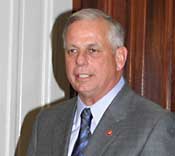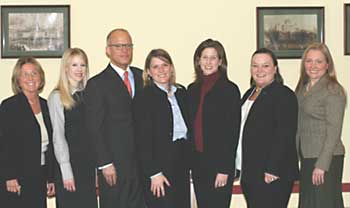Optometry, ophthalmology groups agree on childrens vision care legislation
WASHINGTON — Several bills proposing funding for children’s vision care have failed to make their way through Congress in recent years, but a new bill carries more hope of passing, according to vision care advocates.
HR507 takes a new approach to providing follow-up care for children 9 years old and younger, said pediatric ophthalmologist Jean E. Ramsey, MD, who is also a representative of the American Academy of Ophthalmology’s Secretariat for State Affairs.
Dr. Ramsey and others spoke during a Congressional Vision Caucus briefing at the Rayburn House Office Building here Jan. 29. She said ophthalmologists and optometrists generally have not seen “eye to eye” when it comes to vision care legislation for children, but this bill was born from a collaborative effort by the two groups.
“It is nice to see Republicans and Democrats working together, but it is really nice to be in this room and see optometrists and ophthalmologists working together,” said U.S. Rep. John Sullivan (R-Okla.).
A joint effort
|
Images: VCA |
The American Academy of Ophthalmology and the American Optometric Association have been joined in the effort by Prevent Blindness America, the Vision Council of America and the American Association for Pediatric Ophthalmology and Strabismus.
“We need to put aside our differences and come together, and that is exactly what has happened,” Dr. Ramsey said. “This bill is supported by all the major eye care professional organizations, and that is no small feat. The planets are aligned.
“This is the time to vote for this bill,” she continued. ”The people in the vision field who are here today realize that our goal is for children to be able to see, have normal vision and not end up [spending] the rest of their lives with severe vision loss or profound vision loss in one or both eyes, especially for something that could have been treated.”
Historically, the optometric community has pushed for legislation mandating comprehensive eye exams for all children, while the ophthalmology community supported legislation that mandated screening with appropriate follow-up for children with vision problems. The new legislation would provide states with grants to fund eye exams by an eye care professional — optometrist or ophthalmologist — for children identified as needing such services, with priority given to children younger than 9 years of age, Dr. Ramsey said.
“Children can be identified as needing follow-up care either through a vision screening or a comprehensive eye examination. We are not going down that route. It is a complicated route, and we are going to leave that for the states to decide,” Dr. Ramsey said. “Once the child has been identified and has no insurance and no way to pay for this, that is where these grant funds will kick in, so many states now are stepping up.”
Children’s vision statistics
Of the 20% of children who have a learning disability, 70% have vision problems, according to Andrea P. Thau, OD, FAAO, FCOVD.
“Nearly 4 million children nationwide have impaired vision,” she said at the briefing. “There are so many children now being labeled as having learning problems, and the vast majority of them have never had their eyes checked.”
Dr. Thau said most parents take their children to the dentist regularly, but “while teeth are important to well-being and development, vision is crucial, and we have only a certain window of time to make sure that their brains develop normal vision.”
Vision disorders are the leading handicapping condition in children, according to Dr. Thau.
“But most of these conditions are treatable and preventable,” she said. “Vision affects everything. It affects how you develop motor skills and social development, and these children go on to need tremendous amounts of services. The key issue here is identifying these children and getting them the care they need.”
Some of the vision disorders affecting children include amblyopia, strabismus, congenital cataracts and glaucoma, said Dr. Ramsey.
“Children with undiagnosed vision disorders can become frustrated in school and labeled with learning disorders or behavioral problems,” Daniel D. Garrett, senior vice president of Prevent Blindness America, said at the briefing. “Through early detection and treatment by a licensed eye care professional, however, the effects of these conditions can be minimal, and in some cases completely corrected if caught soon enough. Unfortunately, far too many children are not accessing the vision care they need, and their families aren’t as well. According to some estimates, only 20% of children are getting vision screenings prior to school, and only 14% are getting comprehensive eye exams.”
|
|
Early detection
Dr. Ramsey said people often wonder why the age of 9 was selected as the cut-off for mandatory screening.
“They wonder why we cannot wait until children are 11 or 12 years old to be tested,” she said. “Before 8 or 9 years old is when these problems develop, and, conversely, it is the only time we can treat them. If you get to it early, the baby may have good useful vision. If not, the baby can have a lifetime of blindness.”
U.S. Rep. Gene Green (D-Texas), co-chairman of the Congressional Vision Caucus, said, “Early detection is important, but unless we can follow up [with funding], it does not work. That is why this is so important. This is one I think we can pass [through] this Congress with the support.”
In general, the grant funds would be directed at children who need it most and have been identified by the state as high risk. Up to 20% of the funds that are granted to a state could be used for education for health practitioners, teachers and parents, Dr. Ramsey said.
“I am hoping that having this program in place will spur other states to develop screening programs,” she said.
Dr. Ramsey is co-director of the Massachusetts preschool vision screening project, where they successfully passed a legislative mandate for children to get screened.
For more information:
- Jean E. Ramsey, MD, can be reached at Yawkey Ambulatory Care Center, 850 Harrison Ave., Boston, MA 02118; (617) 414-4020; fax: (617) 414-4028; e-mail: jean.Ramsey@bmc.org.
- Andrea P. Thau, OD, FAAO, FCOVD, can be reached at 77 Park Ave., New York, NY 10016; (212) 685-2457; fax: (212) 685-5989; e-mail: drthauandassoc@aol.com.
- Daniel D. Garrett, senior vice president Prevent Blindness America, can be reached at 211 W. Wacker Dr., Ste. 1700, Chicago, IL 60606; (312) 363-6032; fax: (312) 363-6052; e-mail: dgarrett@preventblindness.org.


